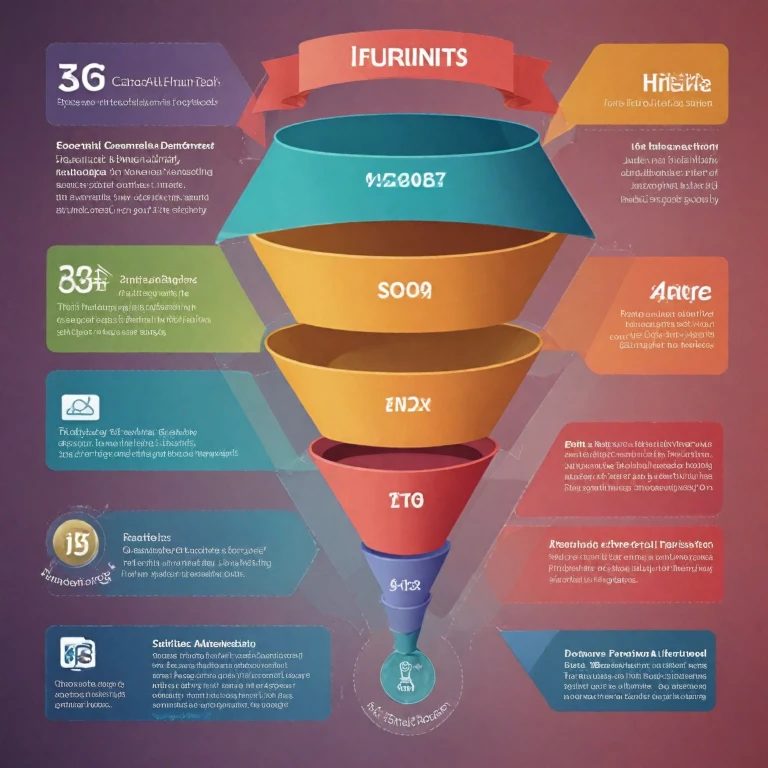Understanding the Full Funnel Approach
Grasping the Complexity of the Marketing Funnel
To effectively harness the power of marketing, it's essential to first grasp the intricacies of the marketing funnel concept. This comprehensive approach divides the customer journey into distinct stages, each with its unique strategies and objectives. By understanding this framework, businesses can better tailor their communication and marketing efforts, ensuring a seamless path from initial contact to conversion.
The full funnel approach enables organizations to strategically align their marketing activities with customer behaviors and needs at each stage. Rather than employing a one-size-fits-all strategy, embracing the nuances of the funnel allows for more precise targeting and nurturing of potential clients. This can significantly enhance customer experience, ultimately driving stronger results and higher satisfaction rates. Additionally, businesses that successfully implement a full funnel strategy can transform leads into loyal customers by addressing their specific needs and pain points at every stage of the buying process.
In the subsequent sections, we'll delve deeper into how to cultivate strong brand awareness at the top of the funnel, which lays a vital foundation for engaging customers in later stages. Building a robust top-of-funnel strategy is often the first step in turning prospects into paying customers. For more insights into how customer experience can impact your business growth, feel free to explore this article on
unexpected ways to enhance customer experience and drive business success.
Building Brand Awareness at the Top Funnel
Building a Strong Foundation for Brand Awareness
Establishing brand awareness is the vital initial step in any comprehensive marketing strategy. At this stage, the objective is to capture the attention of your target audience and plant the seed of recognition. A well-defined brand identity is crucial, allowing your audience to connect with your company's values, products, and mission. This connection forms the backbone of a lasting relationship between the brand and consumers.
Social media platforms, content marketing, and search engine optimization (SEO) are three pivotal tools in your arsenal to enhance brand visibility and recognition. By crafting engaging content that resonates with your audience, businesses can increase their reach and establish a solid presence within their niche. Additionally, paid advertising initiatives such as pay-per-click (PPC) campaigns can propel your brand to the forefront of potential customers' minds.
A successful brand awareness strategy is also data-driven, leveraging insights to continuously refine and improve your approach. By tapping into
enhanced customer experience analytics, companies can better understand consumer preferences and trends, ensuring their messaging is both relevant and impactful.
In summary, the top funnel phase of building brand awareness requires a comprehensive strategy that combines creative storytelling with data-driven insights. This foundation not only sets the stage for engaging customers, as discussed in the following section, but also for converting them further down the funnel.
Engaging Customers in the Middle Funnel
Driving Engagement: Captivating Your Audience in the Middle
After successfully sparking interest at the top of the funnel, it's time to captivate your audience in the middle funnel where engagement truly makes a difference. This phase is crucial as it represents the stage where potential customers are evaluating options and seeking valuable information to make informed decisions.
To effectively engage your customers, developing a personalized communication strategy is key. Tailor your message to address the specific needs and pain points of your audience, offering solutions that resonate with them. Employing techniques like email marketing, retargeting ads, and interactive content can create meaningful engagement while nurturing relationships with your prospects.
Content is king in this stage. Create compelling content that educates and informs potential customers, providing them with insights into how your product or service can solve their problems. Webinars, in-depth articles, and engaging videos are powerful tools to maintain a connection and build trust.
Moreover, leveraging technology can significantly enhance your engagement strategies. Innovative tools powered by artificial intelligence can offer personalized experiences that are crucial for capturing interest and maintaining involvement. To delve deeper into how AI can transform business strategy and customer engagement, you can explore
how AI is reshaping business strategy.
Ultimately, engaging your audience at this stage requires a commitment to understanding their journey and providing them with value at every interaction point. By keeping them informed, involved, and intrigued, you set the stage for a seamless transition to the bottom funnel, where conversion becomes your main focus.
Converting Leads at the Bottom Funnel
Turning Prospects into Customers
As we move into the pivotal stage of the full funnel marketing framework, the focus shifts to converting leads into paying customers. This stage is crucial as it reflects the fruition of your efforts in the earlier stages of creating brand awareness and engaging prospects. Here, every strategy and tactic leads to the ultimate goal – turning interest into transactions.
To maximize conversions, understanding your customer's journey is essential. By this point, your potential customers have engaged with your brand, explored what you offer, and are now deliberating a purchase. They require precise nudges that reassure them of their decision to pick your product or service over competitors. This is where targeted marketing campaigns play a significant role. Personalization becomes key, as tailored messages can address specific concerns or doubts that prospects may have, moving them towards making a purchase decision.
Utilizing customer testimonials, detailed product demonstrations, or promotional offers can be particularly effective in this stage. It’s about showing value, and reassuring prospects that their choice is worthwhile. Equally important is optimizing the buying process itself to ensure it's as seamless as possible, reducing friction points that might deter conversions.
Additionally, maintaining an eye on your data and metrics can offer insights into what’s working and where adjustments might be necessary. Leveraging these analytics helps in refining your strategies, ultimately boosting conversion rates.
In summary, converting leads at this funnel stage requires a delicate balance of persuasion, value demonstration, and process efficiency. This ensures that your marketing efforts culminate in successful conversions, propelling your business towards sustainable growth. For further understanding of how each stage of the funnel ties together into a cohesive strategy, the previous insights on
building awareness might be of interest.
Measuring Success with Key Metrics
Evaluating Your Marketing Efforts with Robust Metrics
As companies ambitiously implement full funnel marketing strategies, tracking the success of these efforts becomes indispensable. Recognizing the effectiveness of actions throughout each stage—from brand building and customer engagement to lead conversions—calls for targeted metrics that reflect the strategic goals set out.
To effectively analyze your outcomes, key performance indicators (KPIs) should be clearly defined for each phase of the funnel. At the top, where the focus is on building awareness, metrics such as website traffic, social media impressions, and brand sentiment offer insight into your overall visibility and the resonance of your brand message.
In the middle funnel, where engagement is critical, interaction-based metrics become pivotal. Tracking email open rates, content downloads, and event participation helps illuminate how well you are capturing your audience’s interest and nurturing potential leads. Engagement metrics reveal the strength of your connections and their readiness to move further down the funnel.
When you reach the bottom funnel, where the goal is to convert leads into loyal customers, conversion rates are paramount. Data such as the number of leads converted into sales, average order value, and customer retention rates provide a clear picture of the effectiveness of your conversion efforts. These KPIs indicate not just immediate success, but also the potential for long-term customer relationships, which align with your broader business objectives.
All these metrics together provide a panoramic view of your marketing strategy’s performance across the funnel. It’s essential to continuously analyze and adjust your tactics based on these insights to ensure alignment with evolving business goals and market conditions.
As companies diligently refine their marketing strategies, regularly revisiting these metrics allows them to adapt and grow. By understanding and optimizing your funnel through these robust metrics, your organization can drive impactful results, achieving a cohesive balance between brand growth, customer engagement, and successful conversions.
Case Studies and Real-World Examples
Learning from Success: Real-World Insights
When it comes to full funnel marketing strategies, nothing is more illuminating than examining how businesses have successfully implemented this approach in practice. By dissecting various case studies, we can appreciate the tactical applications of the full funnel methodology and how it drives growth and innovation.
Let’s delve into an example from a leading tech company. This firm prioritized building brand awareness by orchestrating a captivating top-of-funnel campaign that leveraged influencers and user-generated content. This strategy not only expanded their reach but also established a sense of community around their brand. As discussed in previous sections, building brand awareness is crucial at the top of the funnel to set the stage for deeper customer engagement.
Moving to the middle of the funnel, a renowned e-commerce brand took a different route by focusing on customer nurturing. By personalizing communications and creating interactive content that engages potential customers, this brand successfully increased their customer interaction by 30%. This highlights the importance of engaging customers with relevant content, ensuring they remain interested and invested in the brand.
At the bottom of the funnel, a financial services firm excelled in converting leads through precise data analysis and targeted remarketing campaigns. Their approach included using analytics to understand customer buying behaviors and preferences deeply. This strategy enabled them to send personalized offers and messages at just the right moment, significantly boosting their conversion rates. This aligns with our focus on converting leads efficiently and driving sales growth at the bottom funnel level.
By analyzing these cases, it becomes evident that a full funnel approach requires a harmonious blend of creativity, targeted strategies, and continuous measurement. Learning from others' successes and understanding the metrics of their triumphs will empower businesses to fine-tune their own marketing strategies and achieve exceptional results.

